THE OPENING is all about introducing the fascinating, quirky and wonderful people working in and around the visual arts in Vancouver.
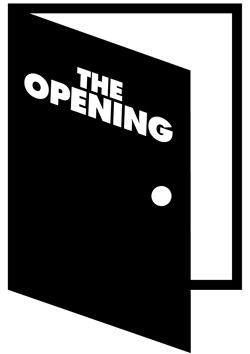 |
|
THE OPENING is all about introducing the fascinating, quirky and wonderful people working in and around the visual arts in Vancouver. Each week, we’ll feature an artist, collective, curator or administrator to delve deep into who and what makes art happen! |
Bryan Newson is the Manager of the City of Vancouver's Public Art Program. He and his staff have been responsible for bringing you everything from Ken Lum's Monument for East Vancouver to Rodney Graham's Aerodynamic Forms in Space, and hundreds more. I met with Bryan a few weeks ago to discuss how he got involved in the creation of the program, what it does, and where it's headed in the face of budget cutbacks.
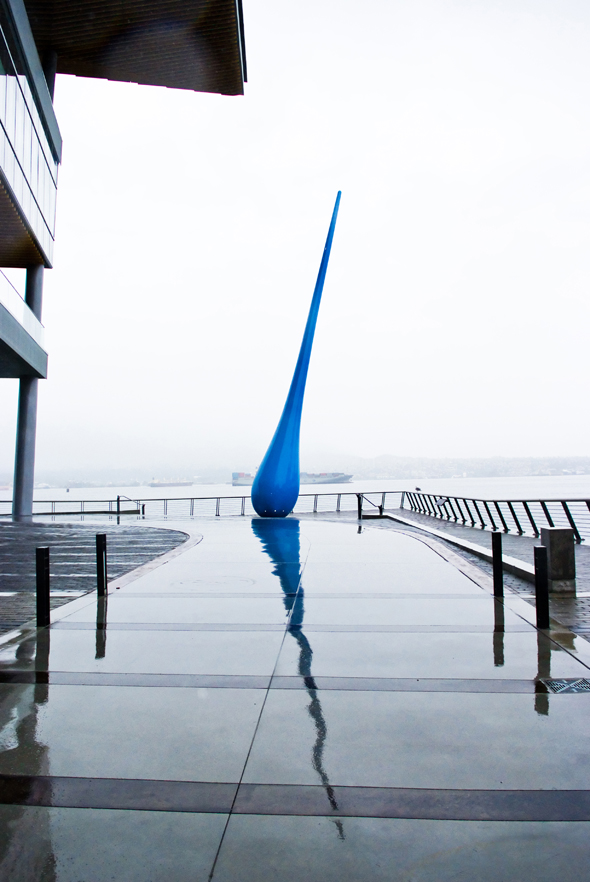
Inges Idée 'Drop'
Can you tell me about what the Public Art Program does for the City of Vancouver?
The Public Art Program is designed to bring artists forward in planning and development processes that are in this city's jurisdiction. This includes finding ways to incorporate artists, their artwork and contemporary art practices, into new facilities such as libraries or community centres. It also provides a mechanism for requiring major private developments such as the larger of the new condos and things coming into the city, to commission new artworks in association with their new developments.
Additionally, it looks after things like what do you do when the government of the Northwest Territories wants to donate an Inukshuk for English Bay. What's the process for handling that, who needs to be consulted? That's actually a gift of state... you just accept those. But if somebody just wants to donate an artwork, and we spend quite a bit of time wrestling with this issue, we go through a few things: What is the artwork? What is its artistic provenance? Is it a good artwork (by which we simply mean does this work merit long-term placement on city land)? The real issue being, there is nothing more valuable than public space or public land. There's tremendous pressure on that land, all sorts of agendas for it. I like to think of this part of the Public Art Program (the part that's not dealing with commissions either for the city or for the private sector, but the part that's figuring out what to do with donations), I see that as a way of protecting public space, or at least bringing some rigor to the discussion about what should go up on public space.
Do you get a lot of art by donation or is most of it by commission?
We used to. When the program started there was a whole tradition, and most of the artwork that was out in the city was donated by somebody.
The Vancouver Biennale (which is I believe three non-profit entities working in some relation to each other), bring in some major artworks and site them around the city. They have approached us seeking permission to site the works on a long-term basis. Up to 30 years was the original request, but I think we're talking about 20 years now. We're coming to an agreement with the Biennale about that. The downside is it means we would take a piece of public space, there would be an artwork there for up to 20 years that people would become familiar with, and then it would disappear. Or it could actually disappear at any point if the Biennale decides to take it elsewhere. The good side is that we'll go through a process of determining the appropriateness of the work and whether it merits the space it's in (and I think in most cases we'll be determining yes it does), and the public gets, at no cost to the city, an artwork for 15-20 years to look at.
At no cost to the city other than the upkeep of the land I'm assuming?
The upkeep of the artwork will be at the cost of the Biennale, because it is selling and fundraising work. They're fundraising right now to try to raise $1.5 million for a piece. If we owned the work, we would be responsible, but if they own the work they are responsible for its upkeep and maintenance and its insurance. Most of these works would be surrounded by a mowing strip. Some of these works are so popular that the grass does not grow! So it is easy for the Parks people to continue to maintain the space around them.
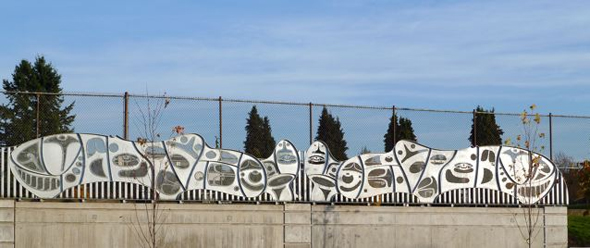
Michael Nicoll Yahgulanaas 'Abundance Fenced'
How does the process differ for approving non-city public art for private developments?
Private developers have three options: they can cash out, which means they give us some money and we can go away and put some art at a site of our choosing; they can take a 60/40 option, whereby they give us 40% of their public art reserve for our use, and with their 60% they just go out and pick an artist, provided the art is in the public realm so that the public can have a free and uninhibited experience of the work.
The final option and by far the one that most developers use, is called our A option whereby they go out and they hire a consultant who has experience with public art and development. The consultant reviews the opportunities for art that are generated as a result of the development, prepares a plan and brings that into the public art committee and myself for review. We review the plan and sign off. The plan includes a procedure by which they will select the artist. Typically they would say they're going to do an invitational call to artists, this is the nature of the opportunity, and the good consultants will have identified 7 or 8 artists whose practices would really lend themselves to the opportunity. It might be sculpture outside, it might be an opportunity to work on glass, it might be two-dimensional, it might be kinetic, it might be light. They'll identify those artists, and then the developer will assemble a selection panel, which must be at arm's length from them. The majority of the persons on that panel will be art-expert in some way - they'll be artists themselves, or curators, or have a real history of art, a prolonged experience of art I like to say. They'll know art. They will make a recommendation or two or three. Typically the list would go from ten down to three. Three would be asked to prepare a model with a provided fee for a more refined proposal, and then a final selection is often made on that basis. Sometimes the selection panel decides before the model stage that one artist is it, and start working directly with that artist. We like them to take a little bit of time to review what's out there and see what's going on, to make a considered and informed decision about what they want to do with their development. I should also say that on the civic public art program, nobody at the staff level picks the art. We always pull together a panel of persons typically combining art expertise with neighbourhood representation when that's appropriate.
Is that the Committee, or is that something separate?
It's not the Committee, no. The Public Art Committee provides public oversight and gives general advice and guidance to myself, city council, the development community and to artists, specifically on public art and the implementation of the Public Art Program, and also on public art matters generally. They would themselves not select the art, but they would oversee the process and approve the process by which that art is to be chosen. They'll want to make sure we're doing our job.
How did you get involved with the Public Art Program?
It has been my great privilege to be involved since its beginning. When I started at the city a long time ago in the late 80s, Expo 86 had just been through the city. There were a number of iconic artwork cum pavilion pieces, these big gestures. There was the Inukshuk from the Northwest Territories, the Korean Pavilion (which is now at Van Dusen Gardens), and a whole bunch of other really interesting artworks. All of those pavilions said look, we'd really like to just donate them to the city. It made no sense for them to take them home. The City had no means and no procedures or criteria in place to say do we want this? How do we make those decisions? Who do we consult? So I was lucky enough to be in the city at the time when it was formulating all those ideas. That really led to our donations policy: What donations would we accept, what would be the criteria, what would we do? That led logically to a discussion. Once Expo was over and gone, I got to looking around the country and elsewhere, and Seattle, Portland and Toronto, among other cities had pro-active programs. They would set funds aside to actually commission artwork. Which seemed like a better way to go overall. I was very lucky in getting support to develop the public art program.
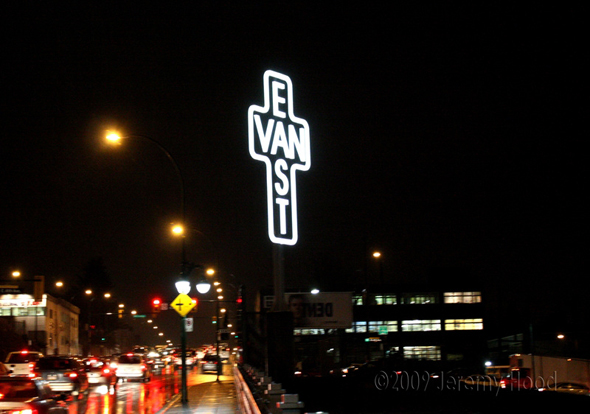
Ken Lum 'Monument for East Vancouver'
Were you involved in art before or were you primarily working in government?
My degree was from UBC in English. I also did a Political Science degree so I had some notion of government and how it works, though not much at the municipal level. I started out in publishing and went to Toronto, where most the publishing at that time was happening. I eventually got a job at an arts magazine and started to get very interested. I started out in the circulation department and then moved up to a minor editorial position. I started to pay attention to art and got very interested in it. When I came back to Vancouver in 1984 I needed a job and did various things. The city advertised for a cultural planning assistant; I applied and was lucky to get the job. The relationship between my background and public art - this is my stretch; to publish means to make public. So okay, how do we get this art out of the indoors? How do we get it to the public, where we can hopefully have a broader discussion about art, what it's doing and what it might be doing? I can't think of anything it shouldn't be doing except boring us.
How do you feel that public art fits into the overall cultural fabric of the city?
There's a movement afoot around the world, in some cities more manifest than others, to conceive of cities as creative places. There's this notion of the idea of the 'Creative City' and there's been a lot of talk by Richard Florida and other people that you need to attract creatives. I've never actually seen myself as a terribly creative person! I think the public art program is a way of making manifest some of the creative forces within the city. And I like to think that the process we have of selecting artists, which is a competitive one, or certainly one that works with those people in the city who are the most informed about art, I really think it's a way of bringing our strongest artistic voices forward. Creating works that contribute to a cultural signature, a cultural identity, that bring distinction, difference and identity to the city, in a way that architecture can and other things can. But providing a place for artists to do that, I think you've drawn on the best and the greatest strengths in your culture and made them manifest. That's my very grand and somewhat pretentious view of some of what the Public Art Program does.
Can you tell me a bit about a couple different existing projects?
I have to say that after we got Ken Lum's
Monument for East Vancouver installed, I thought you know, at this point I can leave this program and die happy. It was a work that I knew Ken had been thinking about for a long time. I think Ken is one of the great artists of the world, and he's certainly one of the great Canadian artists. His work, which is so particular to its place, raises all sorts of issues.
Monument for East Vancouver is the representation of a symbol that was mostly a graffiti symbol that was all over the city and has been at least since the 1940s in various manifestations. The one you most typically see is 'East Van Rulz'. Ken and I have kind of differing opinions of the piece, but I think it's a tribute to the work that it can have a whole range of meanings to a number of different people. As a proud East-sider, where Ken grew up, he in fact sees this not as a symbol of pride, but as he calls it a gesture of defiance. People who live on the East Side refer to it as the Least Side, the Worst Side, all sorts of affectionate nicknames. In putting this piece out, despite what Ken thinks, it became a hugely important source of pride for almost everybody I know who lives on the East Side. Almost everyone loves the piece. There were a few people who were concerned that we were putting up a symbol that had been co-opted by gangs. It's always had sort of a graffiti, slightly underground, slightly unsavory connotation. Ken took all that negative stuff and just put it up as big and as bright and as bold as you could. It has become, through that very process, a symbol of great pride in the city. It does a number of other things that public art should do: It's hugely accessible, it's visible from many places in the city, it has ignited thousands of conversations, it means a number of different things to many different people. It seems to speak to something very important to the whole community on the East Side, in my experience. The word iconic is tremendously overused, but it's the most iconic artwork in the city, I think.
When we got a good budget during the Olympics, we ran a program that we called Artist Initiatives. Public art programs typically have a new community centre or some other infrastructure that they need to place art on. We tell the artist we have a new community centre and this is the history of the area and the building. So you usually get work that has some relationship to the area or the building that necessitated creation of the work. With the Artist Initiatives program, the only one of its kind in Canada, we went to the artists and said we have some money. Rather than have you do a work for a library or a police station that has to have some associated meaning in that context, bring us proposals based on your ideas, your art practices, something that is consistent with what you do best, at a site that you choose, and for those that get selected we'll try to make the site work. Site is everything in public art. Finding the place is the hard part.
Out of that we got all sorts of interesting pieces. The selection panel, which consisted of about five people, including an artist from San Francisco, it [
Monument for East Vancouver] was their universal top pick. And this is not the kind of piece that we would have in the city if all we did was say, well we've got a new skating rink and we want a piece there. I'm not simply tremendously proud to be around when this piece got done, I'm really proud that our program provides opportunities for artists that are free of a lot of constraints, they're as open and unrestricted as we can make them for the artist community.
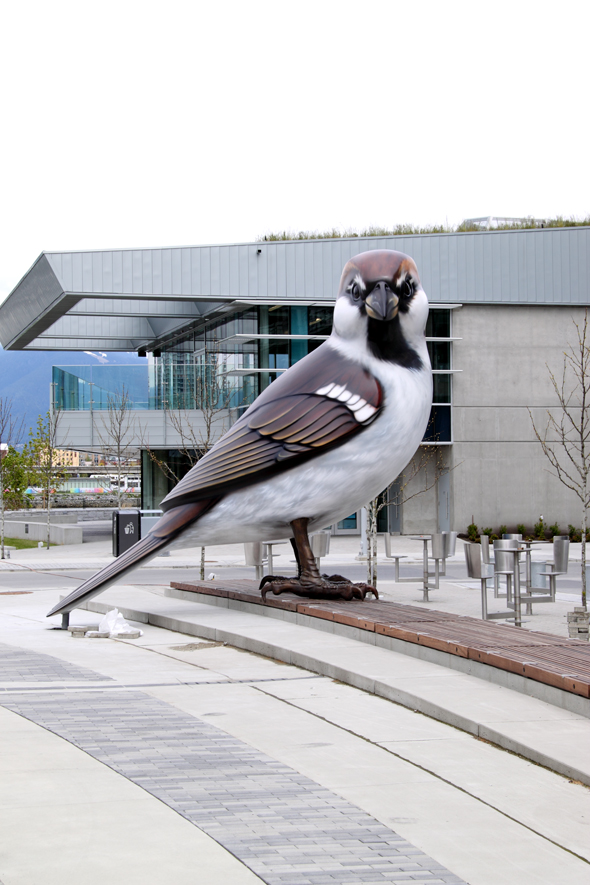
Myfanwy Macleod 'The Birds'
Let's talk now a bit about Myfanwy Macleod's work The Birds.
Myfanwy is a terrific artist, as are all of the artists we've worked with. This was a piece to go down not just in association with birds, not just in association with the False Creek Community Centre, but actually with the whole of the Olympic Village. This piece is about a number of things but it was really addressing a sustainability issue, or at least an environmental issue. These are 17 feet high (obviously over-scale) replicas of the common English house sparrow, which was an invasive species that came in and displaced the local species of birds. It has been very successful in that. It was actually the first wildlife to come down and re-colonize the area once construction was completed. Myfanwy is a huge movie buff so there is also a relationship to Alfred Hitchcock's 'The Birds'. Everyone thinks the sparrow is small and innocent and friendly, but there is actually a slightly menacing element to the fact that you suddenly have birds that are 17 feet high, even though they're not eagles or threatening. There's a slightly ambiguous quality about them that I think a lot of good public art has. The good stuff has a number of stories embedded within it.
What would you like to see for the future of public art in Vancouver? Are there things that other cities have done that you'd like to incorporate here?
I would like the restoration of the public art budget which was fundamentally removed for the years 2012, 2013 and 2014. The $250,000 we got for new projects is less money that the city used to spend in the years (late '80s - early '90s) before there was a Public Art Program.
Wow. Are you going to be primarily donation-based then?
We're going to be donation-based. We'll be drawing on some reserves that we have and completing projects that will carry over from 2011. That's my job before I retire, to get our budget back. The city had a capital spending problem and everybody was looked at to give up funds. When we first got official civic funding in 1994 we got one million dollars for the three-year capital plan. After many years we had gotten that up to two million per capital plan. We were anticipating three, not unreasonably as the program is widely-respected and talked about, and we got $250,000 for the next three years. It literally won't cover the staff or the salaries, so I'm scrambling to keep a fabulous group of people. I should say that it really broke faith with the artist community, because any success this program has had has come directly out of the arts community. Not just those who've done work, but also out of the many arts people who have worked hard on the Public Art Committee, on getting the whole thing going, and on keeping a very rich conversation about public art going. All of that was just basically thrown over the side for 2012, 2013 and 2014.
That's awful. So what exactly does that mean, other than you won't obviously be acquiring any art?
There will be some significant donations coming in. There's the private sector program which is still producing a lot of work. The job is to overcome the perception that the program can get by on no money, because of course it can't. Everybody knows that the city had to curtail, and this is really important, had to curtail its capital funding because of the amount we're paying on debt servicing. Capital funds, which is what funds public art, is largely borrowed money, so you've got different debt servicing costs. A lot of city services are run on revenue, operations and etc, but the capital stuff isn't. So we're certainly pleased to do our part but I would hate to see the program disappear because I think we're missing a tremendous opportunity at no huge cost comparatively - the city has a billion dollar budget now.
I'm confident this council will restore it. They're very keen on the arts. It was just this anomaly where the public art gets funded through capital and the city management had to cut the capital budget. Some of that funding is discretionary and some is not, and yeah we took a hit this time but I'm hoping we can restore funding for 2015, 2016, 2017.
You mentioned you were working on a couple of things from 2011 - what are they?
We're going to do something at the new Trout Lake Community Centre, still to be determined. We have a really cool project by two young artists, Erica Stocking and Vanessa Kwan, scheduled to start soon at Hillcrest Community Centre. We've got a project going in at a little mini park at 3333 Main Street, that will probably be going in the Fall. We're going to be doing a lot of maintenance as well. Council said look, you haven't got money to do new work, but go into your maintenance reserve and do a bit of work there. So we'll certainly focus on that, including restorations to a number of pieces, like the Chinatown Gate. That's not really a public artwork but it's in the nature of a public art work and we agreed to maintain that.
And we will be finally installing a donated piece from the city of Olympia in Greece, which is a Nike statue. It was donated as a result of us having held Olympics, there were just no staff available to get it up during the Olympics. It took quite a while to find a site that was acceptable to everybody. That will be going up downtown, up Cordova Street. It's an abstract. The example image we've got is from China and it's on a base, which we're not going to do. It's by a Greek sculptor, and the city of Olympia is where the Olympic torch relay began. It will have a relationship to the Olympic plaza, there was just no more room to actually put it on the plaza.
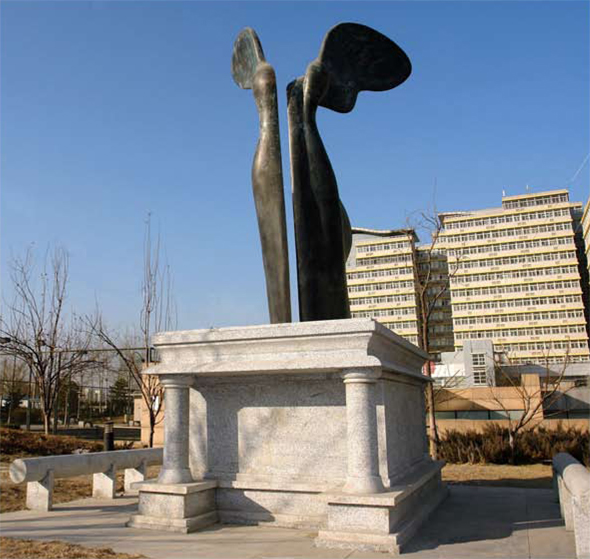
Pavlos Kougioummtzis 'Nike' installed in Beijing
For more information about the City of Vancouver's Public Art Program, please visit their website
HERE.
All images courtesy the City of Vancouver Public Art Program.








